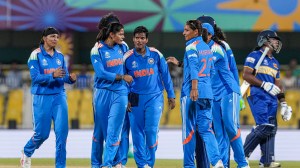Lowbrow hits a low note
Ashim Ahluwalias Miss Lovely,one of the most talked about films at Cannes Film Festival this year,has brought the spotlight back on C-grade films. Once a rage amongst the frontbenchers,the sexually explicit C-Grade film is on its deathbed today. Screen finds out why
While a B-grade film is a cheaper version of an A grade film featuring unknown actors and made on a shoestring budget,a C-grade film relies heavily on uncensored sexual content which is inserted in the film for it to sell
Ashim Ahluwalia,director,Miss Lovely
Away from the humdrum of malls and multiplexes,a small bylane in Grant Road in Mumbai near the notorious red light area ensconces an old,decrepit building that houses Silver Cinemas. It may look like one of the other old,single screen theatres in the vicinity but this one is witness to patrons coming from as far as Panvel and Bhayander to catch a glimpse of the movies screened here. After all,Silver Cinemas is one of the very few single screens left in Mumbai showcasing what are popularly known as C-grade films. Currently screening Love,Sex Aur Multiplex,a Chinese film dubbed in Hindi,the next change will be Jannat Ki Haseena,another foreign language film dubbed in the local language. With ticket prices at ’22,this theatre has survived the test of time by screening these foreign dubbed films high on skin show and sex. We dont get so many C-grade Hindi films,so we screen dubbed foreign films that are equally appreciated, says an old-hand working in this theatre on conditions of anonymity.
The reasons for the recent decline in the number of C-grade films
– Booming multiplexes
– Increasing budgets making it difficult for producers to recover
– Growing audiences for B-grade Bhojpuri films and South dub films
– Digital technology in single screens makes inserting BITS impossible in C-grade films
Actresses shying away from the C-grade film tag
What was once a rage with the front benchers,today even a C-grade Hindi film poster is rare to come by. As of today,the C-grade film industry is almost dead, says filmmaker Ashim Ahluwalia,whose much-talked about film Miss Lovely,a story of two brothers making C-grade films set in the mid-1980s which was a boom-time period for the C-grade films made it to the in-competition Un Certain Regarde section at Cannes Film Festival this year.
Earlier,out of the films churned out every year,80 per cent could be categorised as C-grade films. But over the past few years,the number of C-grade films has dropped drastically, informs producer-director Shakeel S Saifi,who released the low-budget Anjuna Beach last year,based on British teenager Scarlett Keelings murder in Goa.
The ABC of C-Grade films
With Indian films,typically,divided into three categories – A,B and C – the main difference between the B and C grade films is their content. While a B-grade film is a cheaper version of an A grade film featuring unknown actors and made on a shoestring budget,a C-grade film relies heavily on uncensored sexual content which is inserted in the film for it to sell, explains Ahluwalia. Shot in a span of maximum five days in confined spaces with limited resources,a C-grade film is usually released within two months of its making.
While C-grade films in India date back to 1930s,the industry became more pronounced since 1960s. Ahluwalia recalls,In the 50s and 60s,Indians would import illegal porn shot on celluloid from Sweden and insert it in a regular film bypassing the censors. Then in the late 70s and 80s,Indian producers started shooting indigenous C-grade films where they shot BITS,which were extra reels containing explicit sexual content that could be inserted in a film. One of the major reasons for growth of the C-grade films was that small-town India wanted to enjoy these high-wattage cleavage displays that was otherwise inaccessible during the pre-VCD and the Internet era.
As a result,the last couple of decades have been flooded with C-grade fare. Think C-grade films and you immediately think Kanti Shah (remember Vikramaditya Motwanes Udaan where the lead actor,Rajat Barmecha is expelled from boarding school after being caught watching Kanti Shah Ke Angoor?). Known as the king of C-grade cinema,Kanti Shah produced,wrote and directed many superhits during the 1990s including Gunda with Mithun Chakraborty and Loha with Dharmendra that brought immense fan following for these two actors in small towns. Dharmendra did that film when he was older in his Sholay costume. Essentially,they acted in these films at a time when they were at a low point in their Bollywood career, says Ahluwalia.
But Kanti Shah is not the only torchbearer of C-grade films. Filmmakers like Harinam Ansari who made Khooni Dracula (1992),Joginder Shelley,who was seen in Hindi films as villain,made Ranga Khush (1975) that ran for 50 weeks,Vinod Talwar and Ramesh Lakhiani have also churned out C-grade fare. Also,Sapna and Amit Pachori are the biggest stars of C-grade films, informs Saifi. Sapna,who has acted in more than 300 films in a career spanning 16 years,is currently co-producing and acting in No. 1 Dirty Heroine Sapna.
However,over the last decade,the C-grade film industry has suffered a setback since the advent of internet. With access to Internet,people actually started shooting porn for the medium. That rendered the producer-directors making these long,sexually explicit films for theatres useless, says Ahluwalia.
The causes for C-grade industrys decline
The accessibility of sexual content on the Internet is not the only reason that has led to the decline of this industry. The insurgence of multiplexes in the last five years,especially in small towns,has also made it difficult for C-grade film producers with limited resources to find a release for their films. Wasim Siddique of Fame Media,who has been promoting B-grade films since seven years divulges,Earlier,these producers would make films in a budget of ’15-20 lakh and earn a profit of ‘2-5 lakh. But today,no film costs below ’50 lakh and they need to spend atleast some more lakhs in promotions to get visibility. Plus,with so many multiplexes and lesser single screens,it is extremely difficult for the producers to get a release and recover their costs.
The advancement of technology in single screens has not been very advantageous for theatre owners aiming at a packed theatre audience. When there was a system of print reels,it was easier to insert BITS which would assure a sure-shot audience. But now,since we showcase on digital technology,adding BITS to a film is impossible. Even if we manage to do that for one show and get a huge number of audience,we cant assure our patrons the same for the next show due to fear of a police raid, says a source.
Interestingly,today,with the audience for Bhojpuri films having increased considerably,the single screens opt for these regional ventures over C-grade Hindi films. In Mumbai,theatres like Edward and Navrang which would screen C-grade films,now screen Bhojpuri films. Also,now the C-grade film producers prefer to buy rights of cheap South films and dub them for its loyal audience in the Hindi speaking northern belt, says Siddique.
Moreover,not many actresses aiming for a career in Bollywood want to be tagged as a C-grade heroine. While Kanti Shah would give break to many new faces earlier,today,if a Mallika Sherawat wants to enter Bollywood,she will prefer to work with the Bhatts, says Saifi.
Will the C-grade film get back on its feet?
With so many problems plaguing the industry,its revival seems impossible. But that has not deterred filmmakers like Ahluwalia to reminisce the industrys filmmaking techniques. There is something very liberal about the way women were portrayed in these films. While on one hand you could say that they were exploited but they were also the ones actually killing the actors in a thriller in the climax, says the director.
Meanwhile,a more optimistic Saifi claims,This industry will definitely rise again because today,Bollywood industry is facing huge losses. So many director-producers might take this route to recover their money because an audience for these films is still alive.
C-grade stars and their films
Sapna:Maut,Garam,Munnibai,Daku Ramkali,Kharidar
Satnam Kaur: Jorr Jatt Daa,Kamsin: The Untouched,Meri Jung Ka Elaan,Gangobai
Amit Pachori: Kamsin: The Untouched,Meri Jung Ka Elaan,Duplicate Sholay,Patli Kamar Lambe Baal
Shaheen Ansari: Feel: The Touch
Popular C-grade film director-producers
Kanti Shah: Aag Aandhi Aur Toofan,Loha,Gunda,Munnibai,Daku Ramkali,Shaadi Basanti ki Honeymoon Gabbar ka,Sheila Ki Jawaani
Harinam Singh: Khooni Dracula,Gumnam Qatil
Joginder Shelley: Ranga Khush,Aadamkhor,Ganga Aur Ranga
Vinod Talwar: Raat Ke Andhere Mein,Khooni Panja



- 01
- 02
- 03
- 04
- 05




























